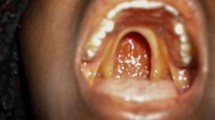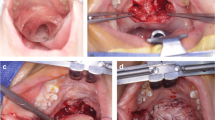Abstract
Background
Cleft palate is one of the most common congenital malformations in the maxillofacial region. After a cleft palate repair, surgeons must deal with the transverse growth restriction and palatal fistulas caused by scar tissue on the raw bone surface around the hard palate. This report describes the technique of the buccinator musculomucosal flap procedure performed together with repair of the cleft palate. The objective is to cover exposed bone areas of the hard palate to decrease scar contraction and subsequent transverse maxillary growth restriction, as well as tension at the closure.
Methods
From August 2009 to February 2012, 15 patients underwent the buccinator musculomucosal flap procedure. First, the cleft palate was repaired by mucoperiosteal flaps, resulting in wide and raw bone surfaces around the hard palate. The outline of the flap was marked on the buccal mucosa. Grounding on the exposed bone areas around the hard palate, the authors designed widths of flaps ranging from 1.5 to 2.5 cm. These flaps were elevated from the buccopharyngeal fascia and turned 90° to cover the raw hard palate bone surfaces. The donor sites were closed by direct suture.
Results
The follow-up period was 1–26 months (average, 10 months). No complications were found in any patient who underwent the procedure, and no fistulas occurred in the midline of the palate. No patients experienced complications related to the donor sites. No trismus or other dysfunction related to mouth movement was observed.
Conclusions
The buccinator musculomucosal flap is a convenient and safe flap procedure with fewer donor-site complications. This procedure also has significant potential for improving maxilla growth and reducing the secondary complications that often can result from cleft palate repair.
Level of Evidence IV
This journal requires that authors assign a level of evidence to each article. For a full description of these Evidence-Based Medicine ratings, please refer to the Table of Contents or the online Instructions to Authors www.springer.com/00266.



Similar content being viewed by others
References
Rohrich RJ, Gosman AA (2004) An update on the timing of hard palate closure: a critical long-term analysis. Plast Reconstr Surg 113:350–352
Rohrich RJ, Love EJ, Byrd HS, Johns DF (2000) Optimal timing of cleft palate closure. Plast Reconstr Surg 106:413–421; quiz 422; discussion 423–425
Meng T, Shi B, Lu DW, Li Y, Wu M (2007) Roles of palatine bone denudation repairing with free buccal or palatal mucosal graft on maxillary growth: an experimental study in rabbits. Ann Plast Surg 59:323–328
Wijdeveld MG, Maltha JC, Grupping EM, De Jonge J, Kuijpers-Jagtman AM (1991) A histological study of tissue response to simulated cleft palate surgery at different ages in beagle dogs. Arch Oral Biol 36:837–843
Bozola AR, Gasques JA, Carriquiry CE, Cardoso de Oliveira M (1989) The buccinator musculomucosal flap: anatomic study and clinical application. Plast Reconstr Surg 84:250–257
Zhao Z, Li S, Yan Y, Li Y, Yang M, Mu L, Huang W, Liu Y, Zhai H, Jin J, Ma X (1999) New buccinator myomucosal island flap: anatomic study and clinical application. Plast Reconstr Surg 104:55–64
Liao YF, Prasad NK, Chiu YT, Yun C, Chen PK (2010) Cleft size at the time of palate repair in complete unilateral cleft lip and palate as an indicator of maxillary growth. Int J Oral Maxillofac Surg 39:956–961
Jonsson G, Hallmans G (1980) Healing of palatal defects with and without skin grafts: an intraindividual experimental study on dogs. Int J Oral Surg 9:128–139
Gröbe A, Eichhorn W, Hanken H, Precht C, Schmelzle R, Heiland M, Blessmann M (2011) The use of buccal fat pad (BFP) as a pedicled graft in cleft palate surgery. Int J Oral Maxillofac Surg 40:685–689
Levi B, Kasten SJ, Buchman SR (2009) Utilization of the buccal fat pad flap for congenital cleft palate repair. Plast Reconstr Surg 123:1018–1021
Ramirez OM (1999) Buccal fat pad pedicle flap for midface augmentation. Ann Plast Surg 43:109–118
Matarasso A (1991) Buccal fat pad excision: aesthetic improvement of the midface. Ann Plast Surg 26:413–418
González-García R, Ruiz-Laza L, Manzano D, Román-Romero L, Moreno C, Monje F (2010) Buccinator myomucosal flap as soft tissue covering for vascularized free fibular flap in anterior maxillary bony defects. J Oral Maxillofac Surg 68:927–930
Freedlander E, Jackson IT (1989) The fate of buccal mucosal flaps in primary palatal repair. Cleft Palate J 26:110–112; discussion 112–113
Ferrari S, Copelli C, Bianchi B, Ferri A, Sesenna E (2012) The Bozola flap in oral cavity reconstruction. Oral Oncol 48:379–382
Conflict of interest
Neither of the authors has a financial interest in any products, devices, or drugs mentioned in this article.
Author information
Authors and Affiliations
Corresponding author
Rights and permissions
About this article
Cite this article
Yang, Z., Liu, L., Fan, J. et al. Use of the Buccinator Musculomucosal Flap for Bone Coverage in Primary Cleft Palate Repair. Aesth Plast Surg 37, 1171–1175 (2013). https://doi.org/10.1007/s00266-013-0198-x
Received:
Accepted:
Published:
Issue Date:
DOI: https://doi.org/10.1007/s00266-013-0198-x




